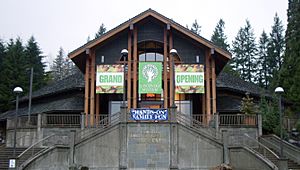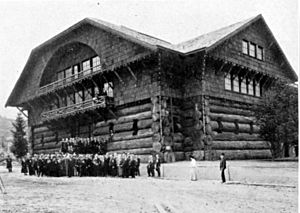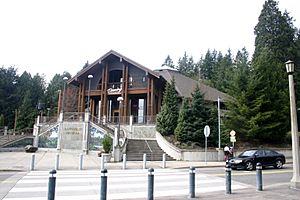World Forestry Center facts for kids

Forestry Center Main building
|
|
| Lua error in Module:Location_map at line 420: attempt to index field 'wikibase' (a nil value). | |
| Established | 1964 (organization); 1971 (facility) |
|---|---|
| Location | Portland, Oregon, United States |
| Type | private: forestry |
| Public transit access | |
The World Forestry Center is a special place in Portland, Oregon, that teaches people about forests and trees. It's a non-profit organization, meaning it's not trying to make money. You can find it in Washington Park, close to the Oregon Zoo. The group started in 1964, and its main building opened in 1971.
Contents
A Look Back: History of the Center
The idea for the World Forestry Center began with a huge log cabin built in 1905. This cabin was part of the Lewis and Clark Centennial Exposition, a big fair held in Portland. It was made from giant trees native to the area and was said to be the biggest log cabin in the world!
People loved the original Forestry Building. It became a popular spot for many years. Sadly, on August 17, 1964, a fire destroyed this amazing wooden building.
Right after the fire, a group of community and business leaders decided to create something new. They called it The Western Forestry Center. A new building was designed by an Oregon architect named John Storrs. This new building was made to be much more resistant to fire. It opened to the public on June 5, 1971, in Washington Park.
In 2005, the museum got a big update. After six months of work and a $7 million renovation, the museum reopened. It now has new, fun exhibits that teach about how we can keep forests healthy. These exhibits focus on trees from the Pacific Northwest and around the world.
What the Center Does: Programs
The World Forestry Center has an important goal: to teach people about forests and trees. They want everyone to understand how important trees are for all life. Their aim is to help create a balanced and sustainable future for our planet.
The center works towards this goal through three main programs:
- The Discovery Museum, where visitors learn through interactive exhibits.
- Two working forests, the Magness Memorial Tree Farm and the Johnson-Swanson Tree Farm, which were donated to the center.
- The World Forest Institute, which started in 1989.
The World Forest Institute helps share information about forests globally. As forestry becomes more complex, it's important for countries to work together. They share ideas on forest trade, rules, and how to manage forest resources. The institute was created thanks to Harry A. Merlo, a leader in the forest products industry. He had a vision for connecting the world through forestry.
A key part of the institute is its International Fellowship Program. This program brings young forestry experts from all over the world to Portland. They work at the World Forest Institute for 6 to 12 months. These fellows often have sponsors, like their employers or governments. They work on research projects that are helpful to their sponsors.
Besides their research, the program helps fellows learn about how natural resources are managed in the U.S. When they go back home, they have a better understanding of how land and resources are cared for here. In 2012, the institute won an award for helping connect Oregon with the rest of the world.
The World Forestry Center campus also has other buildings. These include Julian N. Cheatham Hall, Harold A. Miller Hall, and Harry A. Merlo Hall. The Merlo Hall is where the main offices and the World Forest Institute are located.
Honoring Forestry Leaders
The Leadership Hall of Fame celebrates people who have made big contributions to forestry. You can see photos and stories of nearly 200 forestry leaders here. Their information is displayed in special chests made from beautiful Black Walnut wood from the eastern U.S..
Meet "Peggy": A Special Train
Outside the World Forestry Center, you can see a real steam locomotive named "Peggy." It's displayed with a log on special railroad carts. "Peggy" is a Class B-42 Shay locomotive. These types of trains were like workhorses, used for logging in the forests of the Pacific Northwest.
"Peggy" was built in 1909 in Ohio. She was bought by the Stimson Lumber Company and worked in forests in Washington and Oregon. This tough locomotive even survived the big fires of the Tillamook Burn! She stopped working in 1950.
In 1955, "Peggy" was given to the City of Portland. She was first shown at the original Forestry Building. When that building burned down in 1964, "Peggy" was damaged. She was then moved to a storage area. Between 1969 and 1971, a group of train enthusiasts helped rebuild parts of "Peggy." In 1972, she moved to her current home at the World Forestry Center in Washington Park. Since 2003, "Peggy" has been protected under a roof.
Visiting the World Forestry Center
If you drive to the World Forestry Center, parking costs $2 per hour, up to $8 for a whole day. You can also get there easily by public transit. The Washington Park light rail station is very close. Also, TriMet bus route 63-Washington Park stops at the center every day.
More to Explore
- Montgomery Park (Portland, Oregon), a famous building that was once near the original Forestry Building.
- Vaughn Street Park, a baseball stadium that was also close to the original Forestry Building.




